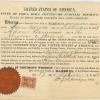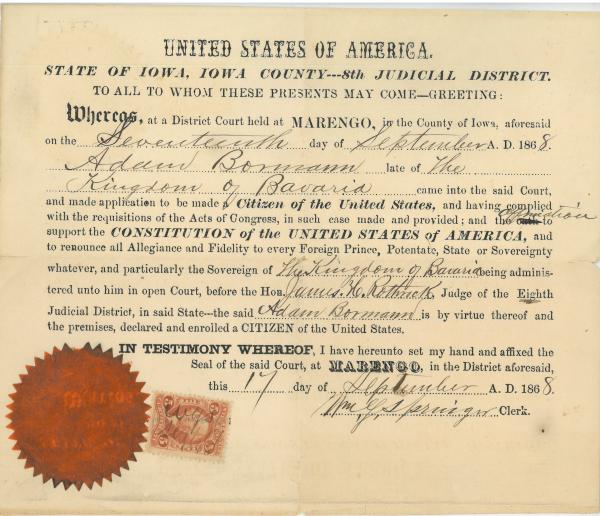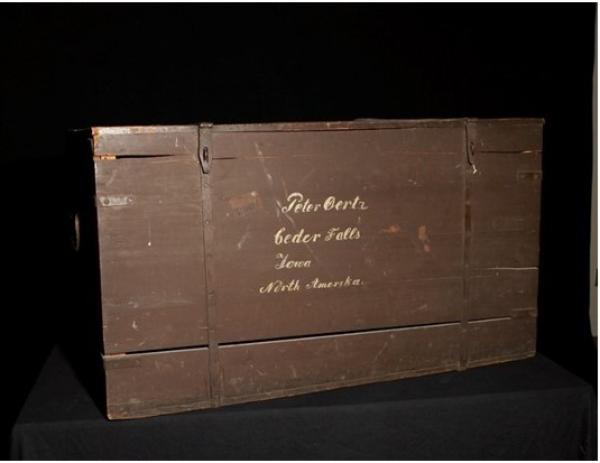Immigration and Iowa
| Grade | 3rd Grade | Class | Social Studies | Length of Lesson | 40-45 Minutes |
| Lesson Title | Immigration and Iowa |
| Unit Title | Immigration |
| Unit Compelling Question | What would compel people to move to a new place? |
| Historical Context: This lesson allows third grade students to expand their knowledge of immigration in the United States and Iowa. Immigration to the United States began when the first non-native traveler landed on the North American continent hundreds of years ago, and continues to this day. After Iowa was opened to settlement in 1833, the rich soil, rolling hills, and available farm land attracted immigrants from England, France, Denmark, Sweden, Norway, and Germany. Communities were established in Adams County (French Icarians), Winneshiek County (Norwegians), Black Hawk County (Danish), and Scott County (Germans), among others. Ellis Island opened in 1892 and for nearly 60 years millions of immigrants passed though Ellis Island. Immigrants came to the United States from countries such as Bohemia, Czechoslovakia, Russia, and Germany, escaping war, famine, and seeking greater opportunity. At Ellis Island they waited in lines for full approval and entry into the United States after which they traveled across the United States using the railroad system until they reached their final destination. Today immigrants come to the United States from all over the world. They may seek employment, education, unification with family, or simply freedom to live their life and seek greater opportunities. Recent immigrant communities to Iowa have included Vietnamese and Bosians. For more information: https://iowaculture.gov/history/education/educator-resources/primary-sou... ~ Teaching Iowa History Team 2018.040.001 This certificate, issued by the District Court in Marengo, Iowa, declared that Adam Bormann, an immigrant from the Kingdom of Bavaria, was a citizen of the United States. Bormann settled in the Amana Colonies, a set of communal villages founded in Iowa County by the Community of True Inspiration, a group of Pietists from Germany, Switzerland and Alsace who fled religious persecution in Europe. The Community of True Inspiration came to the United States in the 1840s and founded a community known as the Ebenezer Colonies in New York. In the 1850s, the group created a new set of communal villages in Iowa known as the Amana Colonies. The settlers of the Amana Colonies maintained an independent and religious lifestyle until 1932. The community then split into two organizations: the non-profit Amana Church Society and the for-profit Amana Society. The Community of True Inspiration was a religious organization founded in 1714 under Eberhard Ludwig Gruber and Johann Friedrich Rock near Himbach, Germany. The group followed the religious formations of Pietism which focused on Bible study, prayer and meeting the spiritual needs of the people by connecting to God. The group was met with controversy as the members did not take part in military duties and sent their children to church-led schools. To escape prejudice, group moved short-term to Buffalo, New York before settling in Iowa. The village was named "Amana", meaning "remain true" from Song of Solomon 4:8. The first Amana Colony in Iowa was founded in 1854 by 800 immigrants from Germany who formed the Society of True Inspirations. Described as a utopian-style organization, the group created a communal society that supported the religious and specific lifestyle that had been persecuted against in Germany. After arriving in Iowa, the colonies expanded to 7 villages spread over 26,000 acres and the residents created an economic living by establishing small businesses such as shops, bakeries, wineries, and through small factories creating furniture and other household items. The society also found work in farming. All residents were guaranteed food, shelter, money and health care in the communal setting, along with being provided a stable retirement plan. Families lived in apartments that were assigned to each family by the elders of the community depending on how new the family was and the size of the family. All buildings in the community were organized in a central pattern to create close connections with each other and in agreement that all property was shared. The religious beliefs of the Amana residents focused on giving care and primary focus to the elderly. Housing was made to benefit the elderly by allowing them to live closer to their families and by creating an economic system that provides longterm care for the elderly. 2018.048.009 This trunk was used by by Peter Oertz, who immigrated from Denmark to Cedar Falls, Iowa, in the late 1870s. Like many other immigrants, Oertz had to fit all of his belongings into this trunk. Beginning in 1840 to the time of WWI, nearly 300,000 Danes immigrated to the United States from their home country in hopes of finding opportunity and work. The Homestead of 1862 convinced many immigrants to head to the Midwest due to their experience in farming. With some settling in Illinois, Indiana and Wisconsin, new railways allowed people to continue on to and settle in states such as Iowa and Nebraska. A large number settled in Southwest Iowa as the landscape reminded them of their home. The towns of Kimballton, Clay, Sharon and Elkhorn soon became the new home to a large number of Danish immigrants, with the 1895 census showing Danes as 64.5% of the population in Clay (including Elk Horn) and 89.9% in Sharon (including Kimballton). |
|
| Lesson Supporting Question | |
| Lesson Overview | Students can use a website to complete an interactive tour of Ellis Island. They can then make connections between Ellis Islands interactive tour and the court documents that states a person immigration into the United States of America. |
| Primary Sources Used |
|
| Resources Needed | Primary Documents from Teaching Iowa History 2018.040.001 and 2018.048.009 https://iowamuseums.pastperfectonline.com/ |
| Standard | |
| Lesson Target | Students will be able to demonstrate what compels people to move to a new place and how the culture of the United States and Iowa was changed by the different immigrant groups. ;Students will be able to make connections between Ellis Island and Iowa. ;Students will be able to make connections between the Ellis Island immigration certificates and the people that reside in Iowa. |
| Lesson Themes | Immigrants |
|
| Formative Assessment (How will you use the formative assessments to monitor and inform instruction?) |
Use the students social studies journals. |
| Summative Assessment (How does the lesson connect to planned summative assessment(s)?) |
There would be a few more lessons based on immigration. Then the question from this lesson would be, "What are some connections between immigration and Iowa?" |
| Author | Taylor Lawson | Created | Last Edited | ||||
| Reviewer: Dr. Chad Timm, Simpson College | |||||||
| Lesson Plan Development Notes: Social Studies Methods, Simpson College, Spring 2019 | |||||||





